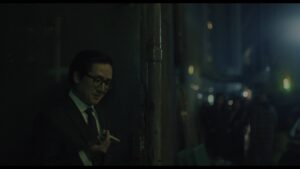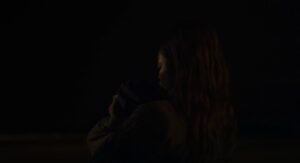Half a decade prior (a lifetime and a pandemic ago), poor Martin Scorsese gave an opinion that vast swaths of the American geek populace has yet to forgive him for. He remarked upon the shiny emptiness of Marvel and the unrelenting comic book movie culture. His opinion was that super hero movies were not cinema but something closer to rollercoasters. Slick, formulaic rides more concerned with rattling the senses and pleasing expectations than pushing the medium forward. There’s a moment early on in Everything Everywhere All At Once (the Best Picture-winning gem by Daniel Kwan and Daniel Scheinert, or the Daniels) where the film all but announces itself as a kind of rollercoaster. As Evelyn’s husband Waymond (or more correctly one of his multiverse doppelgangers) explains the wild rules of hopping between this film’s mirror universes to his wife, he is also preparing us for a two-hour blast of zany forward motion. He is laying out the logic and structure of the film for the audience and starting the countdown to blast-off. As he gives his wife the instructions for starting her genre- and reality-hopping action extravaganza, you can almost feel the safety bar settle snugly against your chest. And then, in an unmistakably propulsive instant, Everything Everywhere All At Once hurtles into the sky and doesn’t come down for 120 exhilarating, teary minutes. Everything Everywhere is the exception to Scorsese’s rollercoaster critique that proves the rule of why the old master is right. It’s no sin to build your movie for fun, laughs, and top speed; to make your film a kinetic thrill ride. The only true failing is to do so obligatorily, uninterestingly, uncinematically. Like a great many vibrant 2022 blockbusters (Nope, The Woman King, Avatar: The Way of Water), the Daniels’ singular film was a call to arms for making popular entertainments with passion, character and thematic vision. Everything Everywhere All At Once was the year’s unforeseeable blockbuster Cinderella story. Movies should be more than just lucrative rides, but cinema itself should essentially act like rollercoasters for our minds and spirits.
I have no interest in using this review to kick Marvel Studios whil they are stumbling. What I am interested in is how films like Everything Everywhere All At Once seized on certain comic-friendly ideas and gave master clinics on how to do execute those ideas better. The Daniels (whose last film was the wonderfully insane Swiss Army Man) debuted their gonzo action dramedy in the unassuming 2022 Spring, four years after Marvel’s record-breaking Avengers: Endgame made the public go crazy for multiverses (parallel realms where the same characters live in tweaked realities) and delieverd a delirious primer on how much potential the multiverse concept holds. Everything Everywhere‘s lovably complex heroine is Evelyn Wang (Michelle Yeoh, majestic and ass-kicking), a harried laundromat owner at the end of her emotional rope. On the single day when the film takes place, she is juggling a struggling business, house painting, a dinner with her stern Chinese father (national character actor treasure James Hong), the impending collapse of her marriage to the sweetly meek Waymond (a magnificent comeback turn from former child star Ke Huy Quan), miscommunication with her lesbian daughter (a strong debut by Stephanie Hsu) and a tax audit (overseen by a fat-suited Jamie Lee Curtis). This is all laid out before an inter-dimensional superspy version of her husband reveals that the universe is about to end and Evelyn is the one Neo-like figure capable of stopping the apocalypse. The bringer of doom is a young woman driven by zealous nihilism. And defeating her followers will require the bitter, defeated Evelyn to pick herself up and quickly learn a new talent: traveling seamlessly between multiverses. The means for doing so involves tricking tim itselby by behaving gizarrely and erratically. In short, zany invention and unbridled absurdism are baked into the very DNA of the Daniels’ gleefully weird, almost confoundingly moving tale of family, choices, hope and the trials of being a small business owner. It’s a film that finds room for cross-dressing cops, waves of giggly sexual innuendo, and tear-jerking reconciliations. It’s a film that runs around you in Daffy Duck circles without ever losing its emotional through-line. For all its flights of fancy (Everything Everywhere is basically made of flights of fancy), it has a throbbing heart that allows it to connect with eve the most avant garde-resistant viewer. It’s downright weird how accessible its weirdness is.
If anyone predicted 2022 having two great action films about the complex bond and friction between mothers and daughters (see also The Woman King; seriously, see it), I’m very impressed. If anyone predicted that one of them would boldly fly the flag of traditional blockbusting while the other would embrace relentlessly caffeinated surrealism, I’m even more impressed. And, for as distinct as Everything Everywhere All At Once is in form compared to a film like The Woman King, both are unmistakably crowd-pleasers. Just as Woman King‘s mainstream exo-skeleton doesn’t make its look at the mother-daughter bond any less potent, Everything Everywhere‘s dizzy dadaism does nothing to weaken its cathartic ideas about parents and their children. There’s a kindred principle between the realms of music and film that says if the artist can put a germ of something simply pleasurable and beautiful at the center of an artwork, they can give themselves more license for absurdism, experimentation and general weirdness. The Daniels dare themselves to be as sugar-high and frenetic and daffy as possible, but they know the glue that holds it all together is the universal catharsis and weepy reconciliation on the other side of the melee. The little bit of simple syrup at the bottom of the whiskey cocktail. Everything Everywhere All At Once can often feel like Daffy Duck’s unhinged “woo hoo!” distilled into cinematic form, but it crescendos in a handful of the year’s most unambiguously emotional scenes. Scenes where kinetic action falls away and dialogue and mutual understanding take the spotlight. It’s a testament to the power and diversity of 2022 cinema that two films multiverses apart in style, tone and setting managed to dovetail where it mattered. Calling your mother more often is the right thing to do in every universe.
Everything Everywhere All At Once is a film that leaves you with plenty to reflect on but a lot of its appeal is also very simple and immediate. In a year that saw the action movie go to deliriously inventive heights, the Daniels’ wacky action tearjerker feels like the proof of concept, the platonic ideal for all the fantastic places action movies went in 2022. All year long, it felt like the festive trumpet blast that summoned a merry cavalcade of bold action bonanzas. None of those other films were anything like Everything Everywhere, and that is as it should be. It’s less the kind of movie to inspire imitators than a call to dream big. It should inspire movies on the whole to be flamboyantly, defiantly themselves. Its ethos is about the staggering array of possibility we find in art and in life and how exciting that is. Saying a movie is about everything is so often a red flag or a cop-out, but this is the rare movie to be about everything in a cohesive way. This also makes the movie’s choice of antagonist (effectively an avatar of nihilism and nothingness) a rich one. Everything Everywhere All At Once is about tapping into our galaxy brains and hoisting our freak flags. And, as action cinema, it moves with its own free-wheeling sense of momentum. Whether you’re seeing a glamorously psychotic teenager pile drive a Carmen Miranda-clad cop or watching a diminutive Vietnamese man turn himself into Jason Bourne by eating a Chapstick, the film twirls and zooms and somersaults with maniacal conviction. Silliness may be the only thing that can save us. It’s the reason so many were happy to see it take home Best Picture, even if there were still-greater films in the hunt. Because Everything Everywhere All At Once is not only great but great in a way that feels representative of what made 2022 remarkable. Emotionally cathartic and personal stories told with singular vision. Touching tales of communication between parents. The action film daring every other genre to keep up with it in terms of sheer scale, of cinematic invention, and of narrative richness.
The feat of Everything Everywhere is not just marrying gorgeous pathos to the action film in a way seldom done. It also manages to tell one of 2022’s most progressively empowering stories. It is a story with a resonant sense of what it is to be an immigrant in America, and an Asian-American in particular. It is evident not only in the intimate authenticity the Daniels bring to these characters (Daniel Kwan is the son of Chinese-American immigrants) but a lived-in familiarity, from the pressures of making parents proud to the struggles of carving out some version of success in a new land. Even the locations, the laundromat and that cozily cluttered apartment, feel tangible and real, tributes to real spaces where real people have lived and dreamed and fought for their happiness. It would be a wonderful thing to even have a standard immigrant drama or dramedy with this much insight and sweet soul. But again, we were privileged to watch it in 2022, when the parameters of genre and tradition were powerless to hem great filmmakers in. So now we have a wise tearjerker your grandmother could watch fused with a wacky action comedy to delight stoners and avant garde cineastes for decades to come. The sense of invention also feels thematically of a piece for a film that is partly about questioning suffocating convention and thinking creatively about how we find ourselves. Welcome to American cinema circa 2022. Where we’re going, we won’t need genres.
Everything Everywhere All At Once is so rich and colorful and full of warmth, I hate to waste any space discussing something as trivial as box office. Its very creation and the volumes of ingenuity and heart that went into that is what really matters. But, for a film that so openly invites its audience to tap into their emotions, creativity and silliness, it actually means a lot that such a wide audience found it and connected to it. It means a lot to the brilliant, undervalued Asian cast that anchors it. It means a lot to a mainstream film landscape that has often felt like it was languishing or going through the motions It means a lot to audiences seeking bold, original works to have their faith rewarded. The Daniels’ funky little hit isn’t going to save the theatrical experience all by itself, but it should be a reminder that revitalizing theater-going won’t be accomplished by Top Gun: Mavericks alone. The success of Everything Everywhere All At Once tells us that people want action but not only action. They want to meet interesting new characters and fall in love with them. They want to cry and laugh and even think. They want a little bit of everything and they deserve it. A Little more than a year later, a sorrowful visionary biopic about the invention of the atomic bomb is close to making Titanic money and it feels very much like a vindication of Everything Everywhere All At Once‘s spark of genius. The two films aren’t remotely alike and yet they both should encourage studios to take chances and not assume people just want more of the same. Maybe we’re ready to to rip up the rule books again and start making the kinds of movies with one foot in the subconscious. It’s time for directors to bring their wildest dreams to the screen, with a renewed faith in audiences to meet them halfway. Give people a ride for their senses and their spirits and the tickets will sell themselves.
































